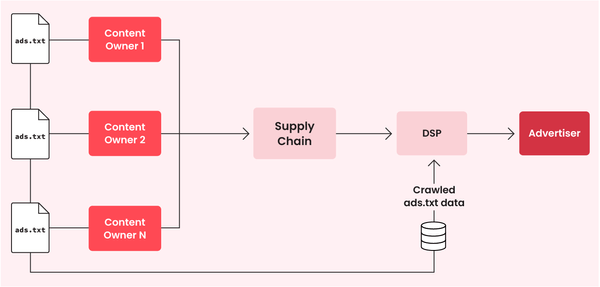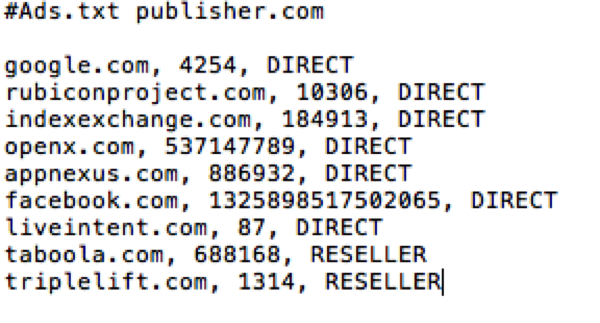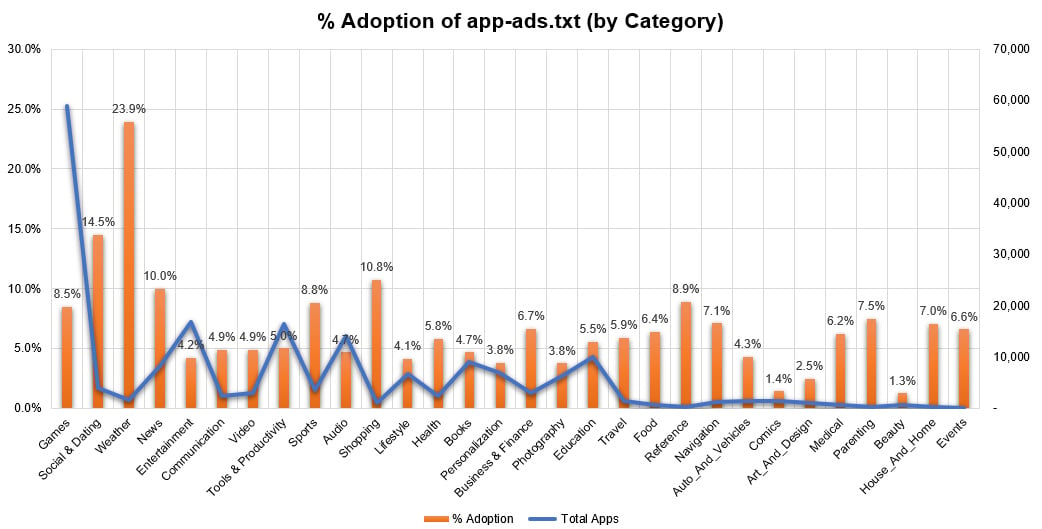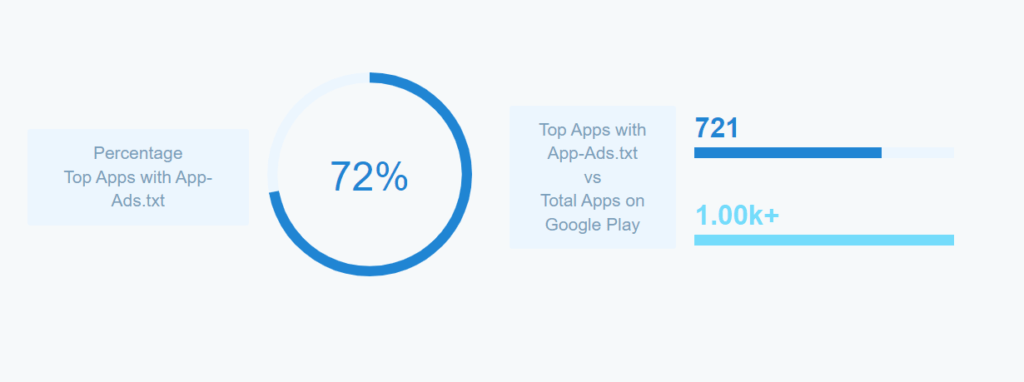What is ads.txt? It’s a file standard created by IAB to help buyers verify whether or not the ad inventory they are purchasing is authentic. Learn more.
Concerned about ad fraud affecting your earnings? Want only authorized sellers who can sell your ad space? Then Ads.txt is all what you need to know about.
It’s a game-changing solution for publishers looking to protect their ad inventory from unauthorized sellers and increase revenue. By keeping an up-to-date Ads.txt file on their website, publishers can take control of their online advertising and safeguard their revenue.
In fact, “The Interactive Advertising Bureau (IAB) is also demonstrating its commitment to transparency and reducing fraud in the advertising industry by releasing an updated version of the ads.txt standard, version 1.1.
This latest update highlights the IAB’s serious approach to utilizing the ads.txt file as a crucial tool in promoting a trustworthy and secure advertising ecosystem.
Let’s dive into the details of what ads.txt is and how it can benefit the digital advertising industry by promoting transparency and reducing fraud.
What is Ads.txt?
Ads.txt (Authorized Digital Sellers) is a simple, flexible, and secure way for publishers to declare the companies authorized to sell their digital inventory. It is an IAB-initiated text file that lists all authorized digital sellers for a website.
Some key points of Ads.txt are:
- It helps to reduce ad fraud by verifying the legitimacy of ad inventory.
- It allows advertisers to buy inventory confidently and eliminates the risk of buying counterfeit.
- The file is stored on the publisher’s website and is accessible to anyone, making it easy for ad buyers to verify the legitimacy of the inventory.
- It is a simple, open-source solution that requires no specialized software or tools.
- Its adoption is highly encouraged by the advertising industry to increase transparency and reduce fraud in the programmatic advertising ecosystem.
Are Publishers Adopting Ads.txt?
Yes, publishers have been adopting the ads.txt. However, initially, it was not being adopted at the rate as it was expected. It is because it is a solution that comes with pretty straightforward process and eliminates one of the biggest problems in AdTech.
As per the Advertising Week, it was found that the by early 2018, the adoption of ads.txt exceeded 50% of the top 5,000 programmatic sites. Now, we have come a long way, and the adoption of Ads.txt have been widespread.
There are multiple reasons behind this, such as:
- The increasing awareness of the benefits of ads.txt, such as improved transparency and reduced ad fraud.
- The growing number of ad networks and exchanges that require publishers to have an ads.txt file.
- The increasing pressure from advertisers to ensure that their ads are being served on authorized websites.
How Ads.txt Helps Prevent Problems?
Ads.txt has a vital role in addressing two things:
- Domain Spoofing
- Arbitrage
Let’s have a look at domain spoofing first.

Domain Spoofing
Domain spoofing, a form of ad fraud, which occurs through two primary methods. The first method involves using malware to tamper with a user’s computer, while the second method entails changing the web address in an ad tag.
Both tactics lead to the same outcome – deceiving ad platforms into believing that the user is visiting a legitimate site, when, in reality, the ad is displayed on a different, illegitimate site or hidden within a web browser.
Arbitrage
Arbitrage, on the other hand, is the practice of purchasing ad impressions and then reselling them at an increased price by a third party. Ads.txt steps in to tackle these issues by providing a clear indication of who is authorized to resell a publisher’s ad inventory.
In a nutshell, it adds a layer of transparency to the digital advertising landscape, ensuring that ads are placed where they are supposed to be, and deceptive practices are kept at bay.
How Does Ads.txt Work?
Ads txt allow publishers to list their authorized digital sellers in a text file hosted on their domain. Here is how it works:

1. File Creation
- The very first step involves creating a file. Publishers create a publicly accessible file on their website that lists all authorized digital sellers for their inventory.
The file specifies the relationship between the publisher and the ad exchanges, supply-side platforms (SSPs), and other entities authorized to sell the publisher’s inventory.
2. Verification by Advertisers
- When an advertiser wants to purchase ad space on a website, they can check the publisher’s Ads txt file to confirm that the seller is authorized to sell the inventory.
- If the seller is not listed in the file, the advertiser can assume that the inventory is counterfeit and avoid purchasing it.
3. Updating the File
- The Ads.txt file is updated regularly to remain current and accurate. This helps to reduce the risk of fraud in the programmatic advertising ecosystem.
By utilizing a simple text file format that is easy to implement and maintain, ads.txt makes it accessible to all types of publishers, regardless of their technical expertise.
Now that you have understood what ads.txt is and how it works let’s look at how buyers can verify it.
How Do Buyers Verify Ads.txt Inventory?
There are a few ways to do this. If both the publisher and exchange have adopted ads txt, buyers can check the ad tags to ensure they have a legitimate connection.
Buyers can also go to the publisher’s website, pull the ads txt file, and manually check if the ad exchange they are working with is listed.
IAB has also launched a crawler that can quickly query publisher websites for the ads txt file; this is great for buyers who need to verify multiple publishers quickly.
Importance of Updating Ads.txt Files Regularly?
Ad Fraud Prevention
Keeping the file updated ensures that only authorized sellers can sell inventory on your domain, which helps prevent ad fraud.
Though Ad.txt can be a useful tool to prevent ad fraud, it’s not a comprehensive solution and should be used in conjunction with other ad fraud prevention measures.
Improved Ad Revenue
By only allowing authorized sellers to sell inventory on your domain, you can ensure that you eliminate the fraud risks, and keep with your ability to reach your revenue potential.
Better Advertisers Trust
By keeping your ads txt file up to date, you can demonstrate to advertisers that you take ad fraud prevention seriously, which can help build trust and increase demand for ad space on your domain.
Best Practices for Keeping Ads.Txt Files in Check
1. Verify the List of Authorized Sellers
Regularly check the list of authorized sellers in your ads.txt file to ensure that it is accurate and up to date. Remove any sellers no longer authorized to sell inventory on your domain.
2. Monitor Unauthorized Sellers
Use tools and services to monitor for unauthorized sellers attempting to sell inventory on your domain. If you find any, immediately remove them from your ads txt file.
3. Keep the Ads.txt File Updated
Regularly update your file to reflect any changes in your authorized seller’s list, such as adding new sellers or removing old ones. This will ensure that your file is accurate and effective in preventing ad fraud.

Courtesy – AerServ
We hope that by now, you are well-versed in all the nitty-gritty of ads txt. That being said, let’s take a look at what app-ads.txt is.
What is Ads.txt for Mobile Apps?
Ads.txt for mobile apps is known as app-ads.txt, and more and more app developers are adopting it. Now you must be wondering why it exists and has been built differently. Here’s why:

Ads.txt for mobile apps refers to a file that lists the authorized domain sellers for in-app advertising. This helps combat ad fraud by ensuring that only approved and legitimate sellers serve ads in a particular mobile app.
However, the implementation of ads.txt in mobile apps faces challenges due to the absence of a standardized location to store the file, unlike in the case of websites where it can be stored on the website’s domain.
Ads txt in mobile apps lacks a straightforward method for storing a list of authorized domain sellers. Unlike websites, mobile apps do not have a dedicated web domain where the ads.txt file can be hosted. Thus, app-ads.txt comes into the picture.
Adoption of App-ads.txt
Approximately 32.31% of all apps on Google Play have implemented “App-Ads.txt”, totaling 1,224,225 out of the overall 3,788,640 apps on the platform.

The estimations by 42 matters also present the widespread adoption rate of app-ads.txt files by Google’s Play Store’s top 1000 apps.

A higher percentage of the top 1,000 apps on Google Play have adopted “App-Ads.txt,” with a rate of 72.1%. This means 721 out of the top 1,000 apps have implemented the standard.
This highlights a greater adoption rate among top-performing apps compared to the overall app population on Google Play
Benefits of Implementing App-ads.txt
Ad Fraud
The app-ads.txt file helps prevent ad fraud by ensuring that only authorized sellers can sell and serve advertisements on a particular app.
This helps to prevent unauthorized parties from exploiting the app to serve fake or low-quality advertisements.
Improved Transparency
The app-ads.txt file provides transparency in the digital advertising ecosystem by making it easier to identify authorized sellers. This helps to improve the overall quality of advertisements and reduces the chances of ads being served by fraudulent or unauthorized parties.
Increased Confidence
By verifying that authorized sellers serve advertisements, app-ads.txt helps to increase the confidence of advertisers, app publishers, and users in the digital advertising ecosystem. This helps to build trust and foster a more secure and reliable digital advertising environment.
WRAPPING UP
In conclusion, Ads.txt and app-ads.txt are simple yet powerful tools that play a crucial role in the digital advertising industry.
Providing a clear and authoritative list of authorized digital sellers helps prevent ad fraud, increases transparency, and improves the overall quality of advertisements.
Its ease of implementation and widespread adoption make it an effective solution for promoting a more secure and trustworthy digital advertising environment.
Moreover, it also recommended that publishers keep themselves updated with the IAB ads.txt updates. Publishers must update their ads.txt files to align with the new changes and maintain compliance.
Whether you are an app publisher, website owner, or advertiser, implementing Ads.txt is vital in ensuring a safe and successful programmatic advertising experience.
Frequently Asked Questions
An IAB Tech Lab initiative, authorized digital sellers, or ads.txt, helps to ensure that your digital ad inventory is only sold by authorized sellers (such as AdSense).
It is not mandatory to use it, but it is strongly recommended. This can prevent counterfeit inventory from being mislabeled as coming from a specific domain, app, or video.
AdSense may take up to 24 hours to process your updated ads txt files. Our Help Center provides more information about ads.txt, how buyers will use it, and how to implement it.
Ads txt files are used by a variety of parties in the digital advertising ecosystem, including:
Publishers
Advertisers
Ad Exchanges
Ad Networks and Demand-Side Platforms (DSPs)
Ad Verification and Brand Safety Companies
Your app-ads txt file is hosted on your app’s domain and can be accessed by adding “/app-ads.txt” to the end of your URL. The file should contain a list of authorized digital sellers for your app, separated by line breaks.

Deepak has a keen eye for detail and a deep understanding of the ad tech landscape. Whether it’s through in-depth articles, thought-provoking insights, or compelling storytelling, he’s dedicated to helping people navigate the complex world of ad tech with the simplicity of his words.








